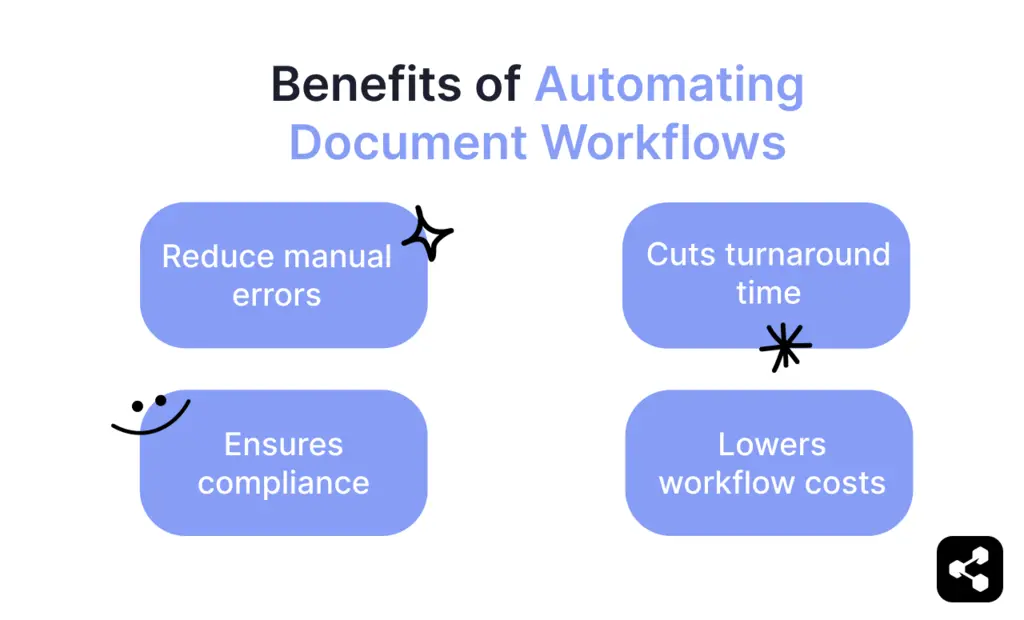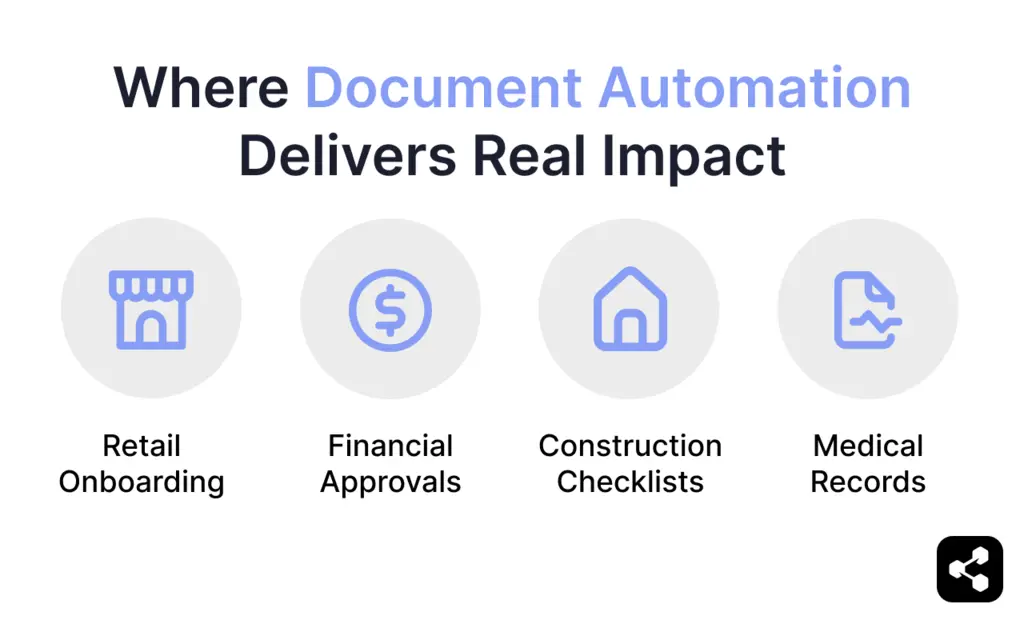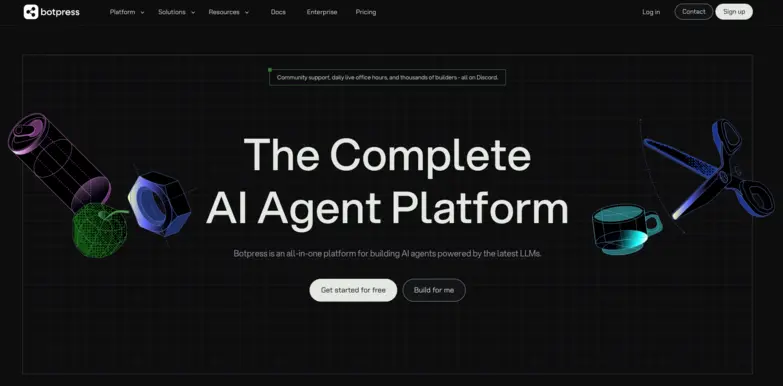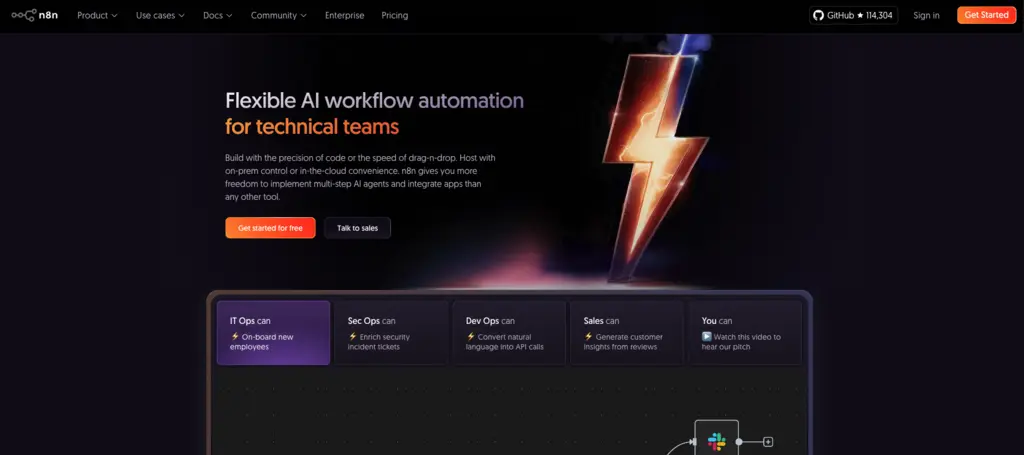- Document workflow automation uses AI to parse documents into structured data, eliminating manual typing, reducing errors, and speeding up approvals across teams.
- Modern AI agents understand document layouts and context, enabling precise data extraction and routing based on rules or content.
- Industries like healthcare, finance, retail, and construction are already saving time and ensuring compliance by automating document-driven processes end-to-end.
- To implement DWA, start by digitizing documents, use AI to extract key data, define routing logic for next steps, and track all actions for compliance and transparency.
Just a few years ago, when I was struggling through Chem 101 in my undergrad studies, the semester took a wild turn — the pandemic hit, right before our final lab practicals.
And instead of exams, the college told us, “Type out your entire lab record into a PDF and submit it.”
Fifty pages of handwritten tables, formulas, reactions, calculations — all manually typed just so we could get a pass grade. Now? I’d scan the whole thing.
AI agents now power workflows that can read my bad handwriting — well enough for me to flag errors, ask questions about the content, ship different versions, and send the document to teammates or managers without retyping a single word.
Document workflow automation is what keeps your handwritten “dilations” from showing up as “delusions” in someone else’s inbox.
What is document workflow automation?
Document workflow automation (DWA) is the use of software to move documents through a set of tasks — like capturing, indexing, reviewing, approving, and delivering — without relying on manual handoffs.
DWA falls under the larger umbrella of business process automation, helping teams replace repetitive document tasks with reliable, AI-driven actions.
Document automation used to rely on rule-based OCR systems that scanned characters and pulled out text. Now, with AI agents, the same workflows are powered by tools that understand how a document is structured and what each part means.
By breaking down content into structured, meaningful components, AI agents can feed that data into systems like CRMs or ticketing platforms so those systems can automatically trigger the right decisions or next steps.
Document Workflow Automation: Key Terms
How does document workflow automation work?
Step 1: Capturing and digitizing the document
The document is uploaded as a file — PDF, DOCX, email, or HTML. Parsing turns that file into a structured representation that the system can understand and work with.
Parsing breaks the document into discrete blocks — titles, paragraphs, tables, lists, and footnotes. Each block is then labeled with contextual metadata that defines its role: whether it’s a heading, a value, a label, or something else.
Parsing builds a layout-aware map of the document, which is stored in a vector database. This map becomes the base layer that AI agents use to reason about what’s inside and how each part connects.
Step 2: Extracting relevant data from each file
The AI agent takes the parsed structure and starts identifying what matters, including:
- Fields and entities: Names, dates, amounts, addresses
- Relationships: Which values belong to which labels, which sections depend on others
- Context: What part of the document does the value come from — summary, footnote, legal clause, etc.
This process is called AI document indexing. Each chunk of content is embedded and stored in a vector database, as a semantic meaning that the agent can search against.
So instead of “scanning” for keywords, the agent can ask:
“Where in this document is the user agreeing to payment terms?”
The agent can still return a precise, context-aware answer, even when the phrasing in the document is completely different.
Step 3: Routing documents through logic and approvals
Once the content is indexed, AI agents can make decisions about what should happen next and to what.
This AI orchestration can apply at two levels:
- Document-level: Send the full file (e.g., a signed contract forwarded to legal)
- Content-level: Send only an extracted section (e.g., a flagged clause or invoice amount)
The AI agent’s decisions are driven by predefined rules and prompts. For example, a builder might instruct their document automation AI agent with:
- If payment terms exceed 60 days, flag for manual review
- If the vendor is approved and the PO is signed, auto-forward to finance
From here, documents begin branching, merging, or resolving based on their content and intended use.
Step 4: Storing and tracking structured document data for compliance
At this stage, the document itself is already stored — what matters now is tracking how it was used.
AI agents log every decision made using the document. These can include:
- What parts of the document were accessed
- What values were extracted and used
- Which version was referenced
- Who approved what, and when
This forms a structured audit trail. It's how you prove a policy was followed, why a contract was approved, or what triggered an action, without digging through emails or Slack.
Tracking like this turns your workflows into accountable systems while increasing adoption.
Key Benefits of Automating Document Workflows

Cuts turnaround time across departments
When someone uploads a document, it’s parsed and delivered — with the right context — to whoever needs to act on it.
Everyone in the loop sees the same structured version from the start, which shortens approvals and prevents repeated handoffs.
This kind of alignment becomes especially powerful in automation use cases, like a lead generation chatbot that routes form responses across teams.
Reduces manual errors in data handling
The automation workflow picks up the file as it is — scanned, spoken, handwritten, or exported — and turns it into structured data.
And considering that 45% of U.S. small and mid-sized businesses still rely on handwritten records to manage employee and vendor data, these mistakes are baked into daily operations.
Automation pulls out what matters and links it to the right record automatically. That means less correction work and fewer errors to begin with.
Ensures policy compliance with transparent workflows
When a document moves through a workflow, you need to know what happened — who approved it, what version they saw, and how decisions were made.
Automation tracks that by default. Every interaction is logged the moment it happens. You pull up the record and know exactly where it stands.
Lowers operational costs from paper-heavy processes
Legacy organizations still run critical operations on paper — high-volume, manual workflows with no upload standards and no structured formats to enforce.
McKinsey reports that 75% of organizations already use AI in at least one function, yet only 1% consider those deployments mature.
Document indexing used to be cost-prohibitive. But with newer visual embedding models, the price of structuring messy inputs has dropped fast.
Examples of Document Workflow Automation
Document workflow automation applies anywhere you need to turn messy, unstructured documents into something a system can understand and work with. That includes scanned forms, PDFs, spreadsheets — anything that wasn’t built to fit into a database.
Automation makes those documents useful. It also gives you a way to track how each piece of information — even a single phrase — is being viewed, referenced, or used across your systems.
The examples below show how that plays out in four different settings:

Reconciling patient records across visits in healthcare
Each patient visit adds more paperwork — intake forms, consent slips, discharge notes, referral letters. But if today’s diagnosis isn’t connected to last year’s prescription, key context gets lost.
Document workflow automation fixes this at the source by letting users route raw documents through a medical chatbot built to structure clinical data.
As soon as a file is uploaded, it’s parsed automatically. Patient IDs, diagnoses, medications, and provider names are extracted, normalized, and linked to the patient’s existing record.
Instead of waiting on record requests, care teams get a connected view. Every visit, procedure, and prescription shows up in context, right when decisions are being made.
Flagging non-compliant payment terms in finance approvals
Invoices show up broken. Some arrive as scanned images with no metadata. Others are spreadsheets where the tax fields don’t line up or totals don’t match the contract.
Each one has to be read, verified, and followed up on across emails or Slack threads. That stalls every payment.
Document workflow automation parses invoices on arrival, extracting PO numbers, tax amounts, line items, vendor names, and checking them against contract terms. Finance chatbots can flag mismatched terms using this data before the invoices are approved.
Detecting employee/vendor rule violations in retail onboarding
As businesses expand across borders and shift to hybrid operations, the onboarding load for both employees and vendors grows fast.
Vendors submit files in their companies’ formats. Contractors upload documents from mobile apps. Some forms are scanned copies from last year’s onboarding cycle — others are missing entire sections.
Document automation reads each one as it arrives. It pulls out IDs, tax details, and role classifications and checks them against what your systems already know.
Anything expired or out of alignment gets flagged before HR or procurement has to touch it.
Auto-filling site compliance checklists in construction workflows
On construction sites, documentation shows up however it can. Field engineers snap photos mid-task — unlabeled, sometimes out of order. Checklists get printed, filled out by hand, scanned in low light, and uploaded days later.
My dad sees this every week, managing civil infrastructure builds in telecom. With hundreds of employees spread across dozens of sites, there’s no time to clean up inputs, but the data still needs to make sense by the time it’s reported.
Each file is anchored to the right site, task, or inspection. The automation system fills in what it can using a structured checklist.
Top 5 Tools for Document Workflow Automation
1. Botpress

Best for: Teams building automation that starts in conversation but needs to reach deep into software, documents, APIs, and logic-heavy workflows.
Botpress is an AI agent platform that gives you control over how document-driven tasks are handled in real time through native AI document indexing through natural conversations.
It’s built for use cases where the inputs range in both medium and format, and where decisions depend on parsing what's in a file, asking for more context, and routing actions through connected tools.
This comes into play often with approvals, onboarding, reporting, and support — anywhere a document holds the information, but a person needs clarity or next steps.
You define how the AI behaves using flows, memory, and prompts. You can pass data into APIs, which, once indexed, can be used to create agents that make decisions based on what they find.
And while being robust to different data types, the platform gives you easy integrations that can easily help you deploy the pipeline on different platforms like a WhatsApp chatbot or a Telegram chatbot.
Features that support document workflows:
- Upload files into a knowledge base and extract specific answers through chat
- Connect CRMs, form tools, communication channels, or signature platforms
- Use dynamic flows to collect missing fields or confirm information mid-conversation
- Deploy to Slack, WhatsApp, Telegram, or directly into your internal tools
Pricing:
- Free Plan: Includes core builder, 1 bot, and $5 AI credit
- Plus: $89/month — flow testing, routing, human handoff
- Team: $495/month — SSO, collaboration, shared usage tracking
- Enterprise: Custom — for custom setups, high volume, or compliance controls
2. Zapier
.webp)
Best for: Non-technical teams trying to automate document workflows without getting deep into the intricacies of data handling
Zapier is an AI orchestration platform built for stitching tools together. When a document lands, Zapier can move the data, update systems around it, trigger the next step, and make sure everything is done with the data in sync.
You create Zaps — lightweight workflows that react to triggers and run a series of actions. A file upload from a user can lead to a new CRM entry, an email, a message to Slack, or a task handed off to a teammate.
Zapier works well alongside platforms like Botpress. A document parsed in conversation can be sent to Zapier, which then routes it through a form filler, a signer, a calendar, or an analytics tool.
Key capabilities for document automation:
- 6,000+ app integrations — CRMs, forms, signers, storage, databases
- Webhook and API modules for flexible document triggers
- Branching logic, filters, and formatters for structured workflows
- Pairs well with bots or front-end agents that need reliable backend execution
Pricing:
- Free: 100 tasks/month, single-step flows
- Starter: $29.99/month — 750 tasks, basic logic
- Professional: $73.50/month — multi-step flows, filters, paths
- Team & Company: Custom — for scale, access controls, and support
3. n8n

Best for: Small-scale, self-hosted setups where documents need to be ingested and passed straight into another system.
n8n is an automation platform where you build flows by connecting steps — a webhook, a parser, a database, a bot.
It runs on your server or cloud instance, and it gives you a visual way to decide how data moves between apps.
For document automation, it handles the transport layer. Once your document is processed elsewhere, n8n becomes the system that sends the content where it needs to go with an API.
It has one of the best connector libraries out there, it works well as a bridge between document agents, CRMs, signers, dashboards, and bots.
Key capabilities for document automation:
- Self-hosted automation engine with full visibility into execution
- Nodes for HTTP, file handling, data transformation, and service calls
- Compatible with OCR, parsing, and LLM services via API
Pricing:
- Self-hosted: Free
- Cloud Starter: $20/month — 5,000 executions
- Cloud Pro: $50/month — multi-user, higher volume
- Enterprise: Custom — SLAs, advanced access, private hosting
4. PandaDoc
.webp)
Best for: Teams that need to generate polished, trackable documents across multiple platforms
PandaDoc is a document generation platform that is capable of automating workflows around documents that are tied across multiple platforms. PandaDoc sits closer to sales and account ops than backend automation.
You set up templates, pass in a few fields, tie the platforms that need to communicate and the platform gives you features to make the pipeline reliable.
It works well where a chatbot or AI agent collects inputs from users and then passes it to PandaDoc to generate a proposal or pre-filled agreements.
Most teams start with the Essentials plan, which doesn’t include the full automation toolkit. That makes the platform harder to recommend for complex workflows. Still, the core integrations and delivery framework are strong enough to justify its place here.
Key capabilities for document automation:
- Embedded eSignatures that track views and status
- Role-based access and version tracking for team workflows
Pricing:
- Free: Basic eSignatures and document uploads
- Essentials: $19/month per user — templates and content library
- Business: $49/month per user — CRM integrations and custom workflows
5. DocuWare
.webp)
Best for: Teams in regulated industries that need secure storage and rule-based document routing.
DocuWare is a document management and automation platform built for scale. It focuses on structure in document workflows and works by capturing files, extracting data, and routing them through predefined workflows with strict access control.
It’s used most often in HR, finance, and legal, where documents are most likely to get audited. You set up the flow, and DocuWare handles the parsing, validation, handoffs, and version tracking behind the scenes.
The platform leans toward control over flexibility, but for teams that need visibility and compliance from day one, it’s a dependable layer in the stack.
Key capabilities for document automation:
- Workflow builder with task logic and approvals
- OCR-based indexing for scanned files
- Role-based access and audit logging
- Retention policies for compliance workflows
Pricing:
- Custom: Based on users, storage, and feature access. Cloud and on-prem options are available.
Start Automating Document Workflows
Anyone can scan a PDF — but if you want your documents to drive real outcomes, you need structure.
Botpress connects and parses content from PDFs, tables, Notion pages, spreadsheets, websites, and more, turning raw inputs into queryable data your AI agents can act on.
That data moves automatically across users, tools, and systems, guided by the dynamic context of each query. With built-in HITL and multi-channel deployment, you can scale document automation that works alongside your team.
Start building today. It’s free.
FAQs
Can document workflow automation handle documents in multiple languages?
Yes, document workflow automation can handle documents in multiple languages because modern AI models are trained on multilingual data and can process text in various languages. However, accuracy can vary depending on how well the AI has been trained on specific languages, dialects, and character sets, so businesses dealing with less common languages should test thoroughly before deployment.
Is it possible to integrate document workflow automation with my existing CRM or ERP systems?
It is possible to integrate document workflow automation with existing CRM or ERP systems, as most modern platforms support API connections that allow data from documents to flow into customer records and operational databases.
What types of businesses benefit most from document workflow automation?
Businesses in industries like healthcare, finance, legal, insurance, construction, and retail benefit most from document workflow automation because they deal heavily with high volumes of forms, contracts, invoices, reports, and compliance records. Any organization with repetitive, document-heavy processes can save time by automating how documents are handled and routed.
How secure is the data processed through document workflow automation tools?
Data processed through document workflow automation tools can be highly secure because reputable platforms use encryption and audit trails to protect sensitive information. However, security depends on the chosen vendor and how the system is configured, so businesses handling confidential data should verify the provider’s security certifications.
Do I need technical skills to set up document workflow automation, or can non-developers handle it?
While some advanced document workflow automation setups require technical skills for custom integrations or API configurations, many modern tools offer no-code interfaces that non-developers can use to build and manage document workflows. Non-technical users can handle tasks like defining routing logic and setting automation rules, but complex implementations still benefit from IT support.





.webp)

